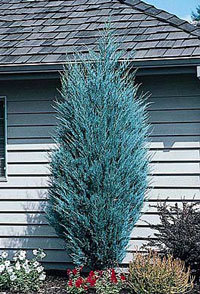

Attractive bluish-green foliage, the narrow column holds its form well without pruning! Excellent vertical accent, useful for landscape framing. Very durable specimen, tolerates heat, cold and drought. Evergreen. Full sun. Slow grower to 10 feet tall, 2½ feet wide. Cutting grown. Slender, columnar-pyramidal compact shrub with blue-green foliage throughout the seasons. Requires little pruning to maintain its form. Attractive accent, hedge or windbreak. Grows well in dry locations. Excellent cold tolerance.
Fertilizing How-tos : Fertilization for Established PlantsEstablished plants can benefit from fertilization. Take a visual inventory of your landscape. Trees need to be fertilized every few years. Shrubs and other plants in the landscape can be fertilized yearly. A soil test can determine existing nutrient levels in the soil. If one or more nutrients is low, a specific instead of an all-purpose fertilizer may be required. Fertilizers that are high in N, nitrogen, will promote green leafy growth. Excess nitrogen in the soil can cause excessive vegetative growth on plants at the expense of flower bud development. It is best to avoid fertilizing late in the growing season. Applications made at that time can force lush, vegetative growth that will not have a chance to harden off before the onset of cold weather.
Light Conditions : Full SunFull Sun is defined as exposure to more than 6 hours of continuous, direct sun per day.
Watering Conditions : Normal Watering for Outdoor PlantsNormal watering means that soil should be kept evenly moist and watered regularly, as conditions require. Most plants like 1 inch of water a week during the growing season, but take care not to over water. The first two years after a plant is installed, regular watering is important for establishment. The first year is critical. It is better to water once a week and water deeply, than to water frequently for a few minutes.
Planting How-tos : Planting ShrubsDig a hole twice the size of the root ball and deep enough to plant at the same level the shrub was in the container. If soil is poor, dig hole even wider and fill with a mixture half original soil and half compost or soil amendment. Carefully remove shrub from container and gently separate roots. Position in center of hole, best side facing forward. Fill in with original soil or an amended mixture if needed as described above. For larger shrubs, build a water well. Finish by mulching and watering well.
If the plant is balled-and-burlapped, remove fasteners and fold back the top of natural burlap, tucking it down into hole, after you've positioned shrub. Make sure that all burlap is buried so that it won't wick water away from rootball during hot, dry periods. If synthetic burlap, remove if possible. If not possible, cut away or make slits to allow for roots to develop into the new soil. For larger shrubs, build a water well. Finish by mulching and watering well.
If shrub is bare-root, look for a discoloration somewhere near the base; this mark is likely where the soil line was. If soil is too sandy or too clayey, add organic matter. This will help with both drainage and water holding capacity. Fill soil, firming just enough to support shrub. Finish by mulching and watering well.
Problems Pest : CaterpillarsCaterpillars are the immature form of moths and butterflies. They are voracious feeders attacking a wide variety of plants. They can be highly destructive and are characterized as leaf feeders, stem borers, leaf rollers, cutworms and tent-formers. Prevention and Control: keep weeds down, scout individual plants and remove caterpillars, apply labeled insecticides such as soaps and oils, take advantage of natural enemies such as parasitic wasps in the garden and use Bacillus thuringiensis (biological warfare) for some caterpillar species.
Pest : Leaf MinersLeaf Miner is actually a term that applies to various larvae (of moths, beetles, and flies) that tunnel between upper and lower leaf surfaces, leaving a distinctive, squiggly pattern. A female adult can lay several hundred eggs inside the leaf which hatch and give rise to miners. Leaf miners attack ornamentals and vegetables.
Prevention and Control: Keep weeds down and scout individual plants for tell-tale squiggles. Pick and destroy these leaves and take advantage of natural enemies such as parasitic wasps. Know the Growing Degree Days (GDD)* for your area to target insecticide sprays when most beneficial for controlling the specific leafminer. Seek a professional recommendation and follow all label procedures to a tee. *GDD numbers should be available from your local Cooperative Extension office.
Miscellaneous Glossary : EvergreenEvergreen refers to plants that hold onto their leaves or needles for more than one growing season, shedding them over time. Some plants such as live oaks are evergreen, but commonly shed the majority of their older leaves around the end of January.
Glossary : ShrubShrub: is a deciduous or evergreen woody perennial that has multiple branches that form near its base.